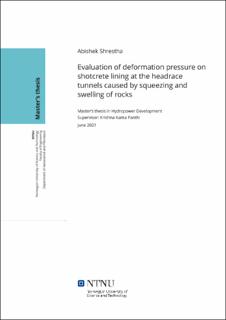| dc.description.abstract | The underground excavation in the weak rock mass is challenging as many stability problems may be encountered during the construction and operation of the underground structure. The stability problem in weak rock may occur due to high induced stress, which results in compressive failure in the underground structure known as squeezing or plastic deformation. The water tunnels constructed in sedimentary rocks with clays, clay shales, or anhydritic shales undergo the swelling phenomenon. During construction, the rock mass is exposed to a dry condition which is later filled with water during operation. In addition, during the operation of the hydropower tunnels, they are often drained and then filled after inspection and maintenance which causes the cycling drying and wetting of rock mass. This process of cyclic wetting and drying in water tunnels passing through weak and heterogeneous rock mass poses is associated with stability problems due to slaking and disintegration. This work is based on the study of the methods to evaluate the stability of the tunnels constructed in weak rock mass containing swelling minerals. The headrace tunnels of two projects La-Higuera hydropower plant, Chile, and Moglice headrace tunnel, Albania are considered for the study.
The La-Higuera hydropower headrace tunnel collapsed after 9 months of operation at the area where the tunnel passes through the weakness zone and rock mass containing swelling minerals. The rock samples collected from the tunnel contain a rich amount of Laumontite of zeolite group ranging from 8.6% to 42.1%. The maximum swelling pressure obtained from the laboratory test of the rock sample was 2.7 MPa which then varied from 5% to 55% to represent the in-situ swelling pressure. The semi-empirical and analytical methods used to evaluate long-term deformation due to rock swelling pressure shows that there is a substantial increase in deformation with the increase in the magnitude of swelling pressure. The numerical modeling carried out using RS2 shows a better extent of the impact of swelling pressure on rock support. The in-situ swelling pressure exceeding 10% of the maximum swelling pressure measured at the laboratory causes a significant increase in deformation suggesting the installed rock support is under-designed to sustain the deformation which eventually leads to the tunnel collapse.
The Moglice headrace tunnel passes through the rock mass containing flysch which is susceptible to swelling and slaking which may cause tunnel instability. The maximum swelling pressure was found to be 0.24 MPa from a swelling test performed at the laboratory on the rock samples collected from the Moglice headrace tunnel. For the stability assessment of the Moglice headrace tunnel, the in-situ swelling pressure is varied from 25% to 55% of the maximum lab swelling pressure to incorporate the possible worst-case scenario. Similar methods used in the La-Higuera project assessment have been used to carry out the stability assessment of the Moglice headrace tunnel. The results of the analyses from all methods show that the deformations due to swelling pressure are very less which is unlikely to cause damage to the installed rock support. The numerical modeling performed using RS2 shows that there is no significant increase in the number of yielded liner and bolts assuring the stability of the tunnel. | |
